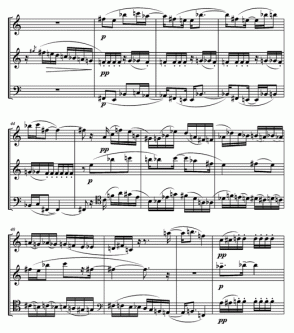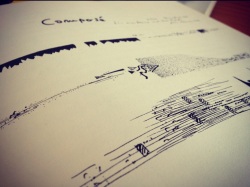Time’s End
“I saw a mighty angel descending from heaven, clothed in a cloud, having a rainbow on his head. His face was as the sun, his feet as columns of fire. He placed his right foot on the sea, his left foot on the earth, and, supporting himself on the sea and on the earth, he raised his hand towards Heaven and swore by Him who lives forever and ever, saying: There will be no more Time; but on the day of the trumpet of the seventh angel, the mystery of God will be completed.” (Revelation 10:1-2,5-7; Oxford Annotated Bible)
 Craft as an extension of faith is something I see a lot of value in. Perhaps it’s in part because of my religious background, but I’ve always been interested in music born out of religious inspiration. This is probably why I’ve entitled my blog “Music for Time’s Ending.”
Craft as an extension of faith is something I see a lot of value in. Perhaps it’s in part because of my religious background, but I’ve always been interested in music born out of religious inspiration. This is probably why I’ve entitled my blog “Music for Time’s Ending.”
I don’t mean the type of music one plays or sings in church nowadays, or sacred choral music or masses, which a lot of composers throughout history composed as a means of an income. The influence of religion in music was not restricted to the walls of churches. In some cases, the composer’s beliefs just naturally bled into the fabric of his or her art in the creation of concert repertoire. Often times, these pieces were inspired by something directly related to their faith, like a passage in the Bible or a life experience; or indirectly, like a religious-themed painting seen in a museum (as in the case of Liszt). Take Franz Liszt’s Deux Legendes: these works obviously weren’t intended to be played in a church during a church service. These were highly virtuosic piano works composed by the composer at the height of his craft that were intended to be played in a concert setting despite their religious background.
Whatever it was, it led the composer to use the medium of sound to capture this inspiration, and then take the music to the concert hall to inspire the listeners. I find it interesting to see how these ideas translated themselves into musical form: perhaps a way of revealing God as a means of reassurance rather than evangelization?
We can speculate. But some time ago, I was fortunate to listen to Olivier Messiaen’s “Quartet for the End of Time” performed by colleague and violinist Alexey Shabalin at Providence College in conjunction with a variety of other artists.
Olivier Messiaen was a 20th century French composer and devout Roman Catholic who often sought to find ways to present the ideas he had into musical form for his listeners to take in. A lot of his inspiration came from the Word as well as Catholic heritage, such as his ever popular Vingt regards sur l’Enfant-Jésus, or “20 gazes/looks at the infant Jesus”; or his Visions de l’amen, a set of piano duets inspired by the individual’s response to creation, sacrifice, and judgement.
Messiaen was also a huge fan of birdsong and considered himself an ornithologist, often imitating the sounds of various birds in his music. He also had an interest in various rhythms, and was especially fascinated with the relationship time had with music (precursor to his Quartet).
 The sketches for “Quartet for the End of Time” first appeared while Messiaen was held as a prisoner of war after being captured by the German army. After meeting three other professional musicians, one a cellist, one a clarinetist, and the other a violinist, Messiaen used this unusual combination of instruments with himself at the piano to form his quartet and premiered the work in front of an audience of 400 prisoners of war and prison guards. In his preface to the score, the composer noted that the composition was inspired by a passage from the Book of Revelation in KJV, which stated, “And the angel which I saw stand upon the sea and upon the earth lifted up his hand to heaven, and sware by him that liveth for ever and ever … that there should be time no longer” (10:5-7). This passage led Messiaen, especially in the face of probable death and an uncertain future, to contemplate the concept of eternity and time: the sense that time as we knew it would cease to exist, as well as evoking the idea of eternity as something in which time was rendered meaningless to human comprehension.
The sketches for “Quartet for the End of Time” first appeared while Messiaen was held as a prisoner of war after being captured by the German army. After meeting three other professional musicians, one a cellist, one a clarinetist, and the other a violinist, Messiaen used this unusual combination of instruments with himself at the piano to form his quartet and premiered the work in front of an audience of 400 prisoners of war and prison guards. In his preface to the score, the composer noted that the composition was inspired by a passage from the Book of Revelation in KJV, which stated, “And the angel which I saw stand upon the sea and upon the earth lifted up his hand to heaven, and sware by him that liveth for ever and ever … that there should be time no longer” (10:5-7). This passage led Messiaen, especially in the face of probable death and an uncertain future, to contemplate the concept of eternity and time: the sense that time as we knew it would cease to exist, as well as evoking the idea of eternity as something in which time was rendered meaningless to human comprehension.
We are present in Time, and God is ever outside of Time. Time becomes a constraint, a separation, if you will.
The way he seeks to illustrate this vision appears through many of the compositional techniques he employs. For instance, in the first movement of this eight movement work, birdsong is used to illustrate the “harmonious silence of Heaven.” The second movement, dedicated to the angel who announces the end of time, features cascading piano chords accompanied by the plainsong-influenced chanting of the violin and the cello. Messiaen described these as the harmonies of heaven. In the third movement’s clarinet solo, titled “Abyss of the Birds,” Messiaen again uses birdsong to evoke the sense of that which is opposite to Time: with stars, light and joyful music as things that are not associated with Time. Near the end, motives return and are subtly altered, parallel to the return of the angel. Finally, the work ends with the violin and piano addressed to the theme of the Word made Flesh: as the piano and violin ascends toward the high registers of their respective instruments, so man ascends toward God. Jesus, as designated by the title of this movement, is a symbol of immortality, of eternity, of someone outside of time itself. It is because of His love that man can reach God and catch a glimpse of this eternity.
This kind of music is the type that is made in the present (or the past) in contemplation of eternity and a subsequent union with God: a healing of the breach, if you will. It’s not music made for after time simply because we don’t know what’s there beyond the leap of faith. We are musicians and composers and artists doing what we can with what we have, in the present, in anticipation of the future. No matter what happens to our music after time is over, we have this right now.
For myself as a musician, maybe I am making music for time’s ending…
With music such as Messiaen’s, we as listeners are left with an overwhelming awareness not only of faith as manifested in art, but also of a testimony of grace at work: within the composer as the creator of this music, and within the heart of the listener as well.
Messiaen left the prison camp three years later and began work at the Conservatoire, where he taught harmony.
Sources:
Wikipedia article about the Quartet
Lawrence.edu
oliviermessiaen.net



You kept me thinking about religion and music and how it´s also influenced by culture …
Fascinating piece! I enjoyed reading that and browsing around here a bit. I’ve often thought of how the potential for music was programmed right into the physics of the universe, and the ability to create and enjoy it placed in us by the Creator. And then there is the cultural overlay and variety. Having now been exposed to music of a very different tradition, that of the Palawano tribe in the Philippines, my eyes are open a little wider. The opening of the blog captured my attention, since I am currently in the process of translating Revelation into Palawano.
Thanks for that.
This is a well-written piece.
Very interesting blog. Music isn’t my speciality and I’m not talented, but I do love music. Such unusual origins.
Music is as much a part of my being as writing. It has had a powerful influence on the course of humanity, but none so profound as faith and religion. Great post!
http://timkeen40.wordpress.com
You write so beautifully… ❤
Besides the fact that our craft can become an extension of our faith, we also must aim for excellence with it because our Creator is the Ultimate Source of creativity and excellence–He deserves our best.
Very interesting!